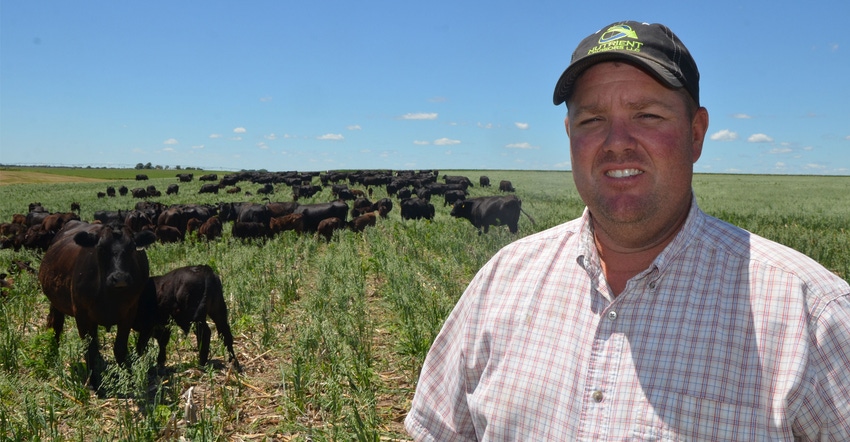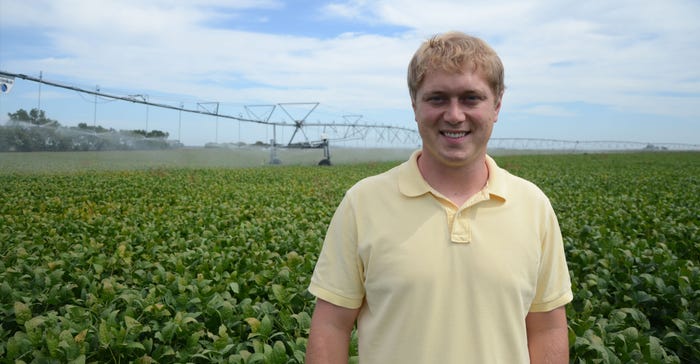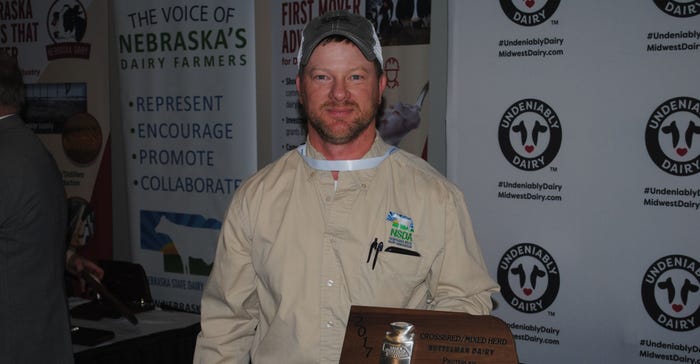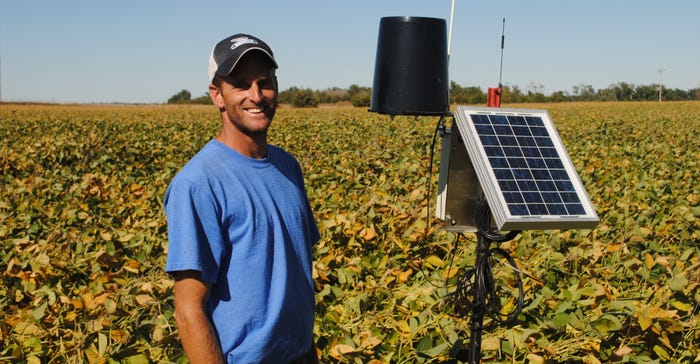
Whether you’re a row crop farmer, cattle rancher, dairy farmer, dryland or irrigated, getting started in production agriculture isn’t an easy task these days. Low commodity prices paired with the high cost of getting started with investments in land and equipment mean it’s harder than ever to get started farming or ranching, especially for those without a solid foundation in agriculture.
However, young farmers and ranchers in Nebraska have been getting creative, and there’s more than one way to get started farming. Nebraska Farmer recently visited with four young farmers and ranchers, ranging in age from 31 to 43, and discussed the challenges they faced in getting started, and strategies and innovations they brought to the table to help along the way.
A new kind of cow-calf system
When most people think of raising beef cattle in Nebraska, they think of cow-calf pairs in the Sandhills or feedlots in western or northeast Nebraska. So when Tyler Burkey, 40, of Milford got started raising cattle, he found he had to write his own playbook.
His system involves raising cow-calf pairs in hoop buildings, as well as grazing annual forage crops and crop residue, and rotational-grazing perennial pasture if needed. This is taking place on roughly 640 acres.
“Probably the biggest challenge was with the system we’re developing, there weren’t a ton of people to model it after. We kind of had to make our own playbook, and we still are,” Burkey says. “This thing is a moving target. We’re constantly evolving and changing what actually works best here. That’s a challenge every day.”
Land access is another challenge for many young producers, although there are ways to expand without thousands of acres, he adds.
“One of the disadvantages we had was we knew we couldn’t grow our operation horizontally; it had to grow vertically,” Burkey says. “That’s a challenge for young producers. Land is such an expensive thing to get into, so that’s why this is working for us. We didn’t have to have huge land investments. We were able to expand our operation and get more out of what we have already.”
Burkey adds that this smaller size provides some advantages in terms of precision management — and opportunities for technology.
“It seems as though we’ve got in our mindset that we have to farm thousands of acres, or own hundreds of cattle to be competitive. And that’s just not true,” he adds. “We actually have advantages some big producers don’t. We have access to those cattle all the time, the ability to utilize AI genetics, to take advantage of technology in the future that helps identify sick calves earlier. I think there are things we can take advantage of that a lot of other producers can’t.”
Bringing an engineer's background to irrigation
Most farmers and ranchers have a degree from some form of higher education. However, it’s not always the case that farmers from the High Plains study engineering in a school on the East Coast before returning home to farm. That was the case for Clark McPheeters, 31, of Gothenburg.
“I received a bachelor’s in bioengineering and worked for a couple years in a fuel cell R&D company, but needed more time in the sun and dirt,” McPheeters says. “I came back in June 2011, and 2012 was a wild year. Since then, it’s been nearly a downhill slide in the commodity markets,” he muses.
As a young, tech-savvy producer, McPheeters notes one of the best ways to overcome economic hurdles is through technology, although there is an initial cost associated.
 TECH-SAVVY: As tech-savvy producer with an engineering background, Clark McPheeters says a top way to overcome economic hurdles is through technology. “As the engineer of hte operation I spend a lot of time evaluating technology such as in-furrow seed treatments and new equipment for higher accuracy liquid applications.”
TECH-SAVVY: As tech-savvy producer with an engineering background, Clark McPheeters says a top way to overcome economic hurdles is through technology. “As the engineer of hte operation I spend a lot of time evaluating technology such as in-furrow seed treatments and new equipment for higher accuracy liquid applications.”

“As the engineer in the operation I spend a lot of time evaluating technology such as in-furrow seed treatments and new equipment for higher accuracy liquid applications.” he says. “When we can spend $2 to $3 an acre and come back with a $10 to $20 return, those are the kinds of investments I like to make, and we evaluate opportunities constantly.”
For McPheeters, irrigation-related technology has been a valuable investment. This includes a combination of soil moisture probes, pivot telemetry and satellite imagery – all three of which work together to irrigate more efficiently and eliminate costly mistakes. Pulling in several sources of in-field data and receiving immediate notification of pivot breakdowns has allowed him to increase days of voluntary load management on his electric wells. This has decreased his irrigation costs by reducing both hookup and consumption charges.
From the economic standpoint, flexible marketing strategies also play a big role.
“We market using a grid with time on one axis and price on the other. This allows us to pick a range of prices where we think the market is likely to run and correlate percentage sold with how much time we have left to market. When we place orders to sell, we evaluate the price points and percentage of crop sold versus our strategy. As prices move higher, we have a benchmark to refer to as we sell our crop,” McPheeters says. “Our goal is to be disciplined and sell some crop when grain prices are at profitable levels. Having a firm but flexible strategy enables us to be more objective sellers.”
Growing from strong dairy roots
Jason Nuttelman farms with his father, Doug, and family on their crossbred Holstein-Jersey dairy operation near Stromsburg. For the 43-year-old dairyman who also serves as a board member with the Nebraska State Dairy Association, farming has changed considerably in the last decade. The family has a strong dairy tradition, with Nuttelman Dairy starting out in 1968 when Jason’s grandfather built his first milking parlor. Today, with his brothers involved in the operation, they have grown their milking herd from 150 cows 10 years ago to 250 head now.
 GETTING RESULTS: Jason Nuttelman picked up the dairy’s first place NSDA Production Award in the Crossbred category at the annual Nebraska Dairy Convention held in Columbus in February.
GETTING RESULTS: Jason Nuttelman picked up the dairy’s first place NSDA Production Award in the Crossbred category at the annual Nebraska Dairy Convention held in Columbus in February.

“Genetics has been a big change for us,” Nuttelman says. “We used to breed everything with bulls, but today, we time-breed everything using artificial insemination technology and just have a cleanup bull.” This has allowed the family to improve their genetics and dairy herd performance exponentially over a shorter period of time, Nuttelman says.
“We’re also benefiting from better genetics in our crops,” he adds. “We grow all of our own feed, including planting and feeding all brown midrib corn for silage” to improve neutral detergent fiber digestibility and intake. The family plants new low-lignin alfalfa varieties to further enhance the digestibility of their homegrown dairy rations.
Nuttelman and his family are also looking to future expansion. They’ve been visiting other dairies over the past five years to explore what they need to incorporate into new facilities when their expansion occurs. It is a long, thorough process that looks several years into the future and to the next generations, Nuttelman says. “One day, we’d like to build a new family dairy facility and maybe expand to up to 600 cows,” he explains. “That new facility might include robotic milking. We are exploring our options and waiting for the right opportunities.”
The future in dairying is bright for Nuttelman and his family. “I like working with my father and brothers,” he says. “And there is also something special about seeing a newborn calf that is the result of genetics I helped select. Sure, there are good days and bad days, but I’m proud of what we’ve been able to build up over time.”
Evolving in-field tech helps boost bottom line
Kyle Heiss and his father, Rod, have learned a few things about in-field moisture sensing technology over the past four years they’ve employed these tools in their irrigated fields near Page. Evolving in-field technology that helps with the farm’s variable-rate irrigation program has been key to their bottom line and to their philosophy on saving water resources.
Currently using Sentek soil moisture monitoring probes, the family has tweaked their management philosophy over the past few years since they installed their first soil moisture probes in the field.
One of the keys to using soil moisture probes in irrigated corn and soybeans is getting the probes in the correct locations in the field.
 IN-FIELD: On Kyle Heiss's farm near Page, soil moisture monitoring and variable-rate irrigation continues to evolve, as Heiss better understands their soils and how to save on water.
IN-FIELD: On Kyle Heiss's farm near Page, soil moisture monitoring and variable-rate irrigation continues to evolve, as Heiss better understands their soils and how to save on water.

“We farm a lot of variable soils,” says Kyle, 39. “We are starting to get a better grasp of where our soil probes should be located. We can tell the differences between sandier soils and those with greater water holding capacity,” he explains. “Now, we don’t just look at the computer models on locating where the probes should be installed in each field. We’ve gained some understanding that the probes should be in spots that best represent the zones in the field, so we monitor more of an average, rather than spots that are too dry or too wet,” Heiss says.
Heiss’s confidence in the soil moisture probes has increased. Four years ago, they employed six probes, but now use a dozen probes, covering more fields in the process. This moisture monitoring technology has caused Heiss to irrigate crops later into the season than they would normally if they were just using visual moisture inspection.
“The probes caught our attention in late season,” he says. “Because of the data we received from the probes showing deficiencies in late season, we’ve tended to put on water a little later, and this has been a big player in increasing production.”
If you look at the water-use data, locations are found within their variable-rate irrigation zones that do not receive any irrigation water all season. “About 10% to 15% of our irrigated fields do not receive any irrigation water during the season,” Heiss says. “If those soils receive a light rain, they are good all year long.”
Four of their center pivots are set up for variable-rate irrigating, with variable frequency drive control panels that drive the electric motor on the well. “We use about half of the electricity thanks to this technology, because the well only runs enough to pump the amount of water that the specific zone is needing,” Heiss says.
Employing the combination of VRI and soil moisture probes has allowed Heiss to save electricity and get water on the crops when and where they need it most to gain in production.
“On one quarter section, we figure we can save 250,000 gallons of water every 36 hours,” Heiss says. “With the scarcity of water resources out there, we’re glad we’ve been able to do our part to be the best managers possible," he says. “Our fields are also grid-sampled, so every pound of nutrients, seed and every drop of water is put out in the field at the right amount in the right spot to do the most good.”
About the Author(s)
You May Also Like








